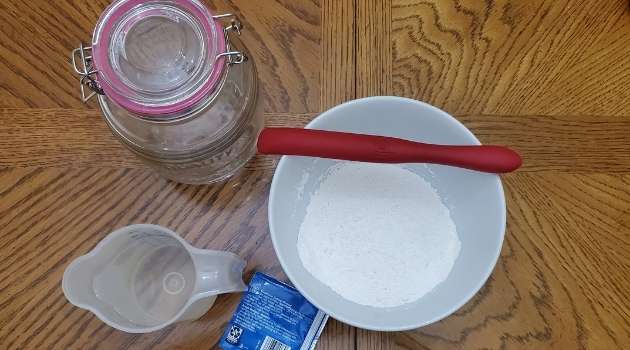Here’s an easy way to make a sourdough starter at home.
If you’ve ever dreamed of baking fresh, crusty loaves straight from your own kitchen, it all begins with a sourdough starter. This simple mix of flour, water, and a little patience is the living heart of every great loaf, nurturing the wild yeast and friendly bacteria that give sourdough its signature tang and chewy texture. Creating your own starter isn’t just a recipe—it’s a small, satisfying ritual that connects you to centuries of traditional baking.
Some sourdough starter recipes are very fussy, with multiple steps, draining off liquid, and daily feedings. I have used this starter many times in the past, and it does not need that constant tending. You’ll give it a quick stir once a day for the first few days. Nor does it demand any special ingredients that you would only find at a specialty grocer.
Whether you’re a first-time baker or returning to an old family tradition, this guide walks you through every step of creating and caring for your own sourdough starter. Use the table of contents below to jump to the section you need most.
Table of contents
- Here’s an easy way to make a sourdough starter at home.
- Why Make a Sourdough Starter?
- What Else Can You Do With Sourdough Starter?
- Four Key Benefits of Eating Sourdough Bread
- How to Make Sourdough Starter from Scratch
- How to Care for Your Sourdough Starter
- Sourdough Starter FAQs
- The Takeaway: This Sourdough Starter Recipe Is Uncomplicated
Why Make a Sourdough Starter?
While supermarket shelves are well-stocked these days, homemade bread is still one of life’s greatest pleasures. There’s just something about pulling a golden loaf from the oven that fills your kitchen with comfort.
One of the best parts about baking with this sourdough starter recipe is the freedom from relying on packaged yeast. The yeast is already thriving in your starter, so you never have to worry about freshness dates or grocery shortages again.
Once you see how easy it is to make a sourdough starter, you’ll wonder why you didn’t try sooner.
What Else Can You Do With Sourdough Starter?
Bread is only the beginning. Your sourdough starter opens the door to all sorts of delicious bakes:
- Sourdough cake.
- Sourdough biscuits (recipe here!)
- Sourdough chocolate cake. (Scrumptious!)
- Sourdough dinner rolls.
- Sourdough pancakes. (Easy to make!)
- Sourdough waffles.
- Sourdough muffins.
- Here’s my favorite–sourdough pizza crust.
You’ll expand your kitchen repertoire while adding that distinctive sourdough depth to familiar favorites.
Four Key Benefits of Eating Sourdough Bread
Registered Dietitian Jessica Ball outlined four key benefits of eating sourdough-based baked goods in an article in EatingWell in 2021.
1 – Sourdough supports a healthy gut
Sourdough bread can improve gut health. The process of fermenting the sourdough starter increases the prebiotic and probiotic-like properties. Ball notes that the most beneficial flour to boost this result is rye flour.
2 – Easier to digest
Fermentation chemically alters the wheat enzymes that might irritate some people. So while sourdough is not a gluten-free bread, it is more digestible because of this chemical process.
3 – Helps to regulate blood glucose
If you have Type 2 diabetes or are on the borderline, you know the importance of monitoring your blood glucose level. Ball explains that sourdough is preferable over white or whole wheat bread because it has a lower glycemic index and glycemic load.
4 – Sourdough pairs well with a Mediterranean diet
Many medical professionals recommend that older adults eat a Mediterranean diet to support healthy aging. One study found that whole-wheat sourdough bread helped reduce the risk of diabetes and heart disease in some senior citizens.
So no, your bread will not be magically carb-free, but it looks like sourdough bread does offer some health advantages over traditionally baked offerings.
How to Make Sourdough Starter from Scratch
Here is how you can start the process.

Time needed: 10 minutes
How to Make an Easy Sourdough Starter
- Tools you need:
One-quart jar with a plastic or glass lid (non-metallic)
Wooden spoon or silicone spatula (I use my trusty spurtle—long-time readers know it’s my go-to tool for almost everything.)
Measuring cups (liquid and dry) - Ingredients:
2 cups flour (all-purpose white, whole wheat, or rye)
2 cups warm water (about 100°F)
1 packet active dry yeast - Steps to mix sourdough starter:
Step 1 – Activate the yeast
Pour warm water into your jar and sprinkle in the yeast. Wait until you see tiny bubbles forming—this means the yeast is active.
Step 2 – Add the flour
Stir in the flour a little at a time until there are no lumps. The mixture should look like thick pancake batter.
Step 3 – Cover and rest
Cap the jar loosely. Place it on a pie pan or plate in case it bubbles over—it often doubles in size during fermentation.
Step 4 – Stir daily
Keep the jar at room temperature and stir once per day for five days. You’ll notice the aroma becoming slightly tangy and beer-like.
By the end of day five, your sourdough starter should be bubbly, earthy, and ready for feeding or baking.
Feeding Your Sourdough Starter
After five days, your starter will be alive and hungry! Regular feedings keep the yeast strong and the flavor consistent.
- Discard half (about one cup if you began with two). This keeps the starter manageable and well-balanced.
- Add equal parts flour and warm water—one cup each—and stir until smooth. The texture should resemble thick pancake batter.
- Watch for bubbles. Within a few hours, the starter will show signs of life again.
- Decide on storage.
- If you bake often, keep it at room temperature and feed daily.
- If you bake less frequently, refrigerate it and feed once a week.
To reactivate before baking, bring it to room temperature, feed it, and let it bubble for four to six hours.
How to Tell When Your Sourdough Starter Is Ready to Use
As your starter ferments over the first few days, you’ll notice the texture change from thick batter to something lighter and airier. A healthy starter should look a bit like bubbly pancake batter—it will rise and fall as it digests the flour —and smell pleasantly yeasty, with a slightly tangy note.
To test whether it’s ready to bake, try the float test. Drop a small spoonful of your starter into a glass of water. If it floats, it’s airy and active enough to raise bread. If it sinks, give it another day or two of room-temperature rest and daily stirring or feeding.
Remember: early batches may rise beautifully but taste mildly tangy. The true sour flavor deepens after a week or two of consistent feeding as your natural yeast and good bacteria mature.
How to Care for Your Sourdough Starter
Your starter is a living culture that rewards care and consistency.
After your initial fermentation, remember that it’s time begin using and feeding it regularly. When you bake, remove about one cup (the discard), then replace it with ½ cup flour and ½ cup water. Stir, cap loosely, and let it ferment at room temperature for about 12 hours before refrigerating again.
If you see a thin liquid layer on top, that’s harmless alcohol (hooch). Pour it off before feeding. If you ever spot green, black, or purple discoloration, discard it and start fresh.
Take care of it, and your starter can live indefinitely. I once had one that lasted more than ten years—until the day I dropped the jar. I was heartbroken.
Sourdough Starter FAQs
Yes, as long as your tap water doesn’t have a strong chlorine taste. If it does, let it sit out overnight so the chlorine dissipates. (Editorial note: I personally prefer to use filtered water!)
That layer, called hooch, is normal. It means your starter is hungry. Pour it off or stir it back in, then feed your starter as usual.
At room temperature, feed it daily. In the refrigerator, feed it once a week to keep it strong and healthy.
Use it to make pancakes, muffins, or crackers! Discard adds flavor to almost any baked good. This post will give you 12 yummy ways to use sourdough discard – waste not, want not.
It may be too cold or underfed. Move it to a warmer spot (around 75°F) and feed it with fresh flour and water to revive activity.
The Takeaway: This Sourdough Starter Recipe Is Uncomplicated
If you want to try your hand at baking a fresh, hot loaf of sourdough bread, but the starter instructions seem too complex, give this a try. It will provide you with a delicious final-baked loaf of bread without a complicated method. You will see that this starter is exceptionally versatile for many recipes.
Originally published in 2022. Updated for 2025 with new instructions, clearer feeding guidance, and improved layout for readers.


